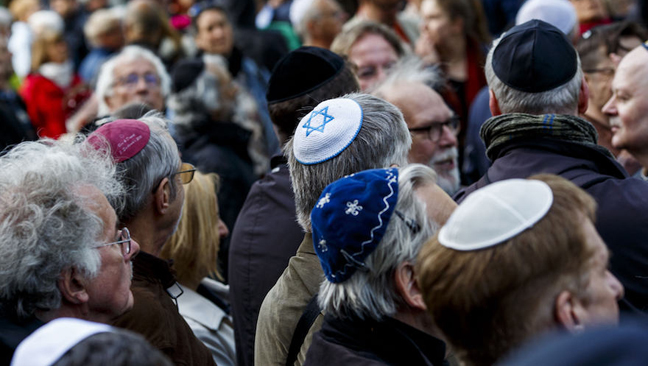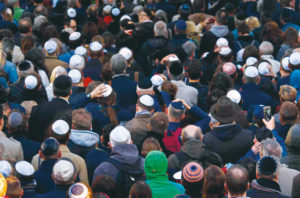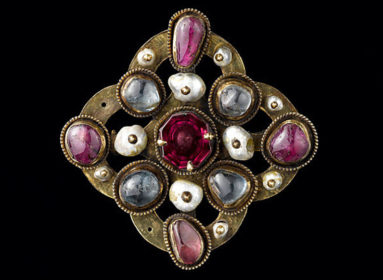
Will Europe’s Jews stop wearing kippahs? Most already have.
By Cnaan Liphshiz
AMSTERDAM (JTA) — The debate about wearing a kippah in Western Europe returned only a decade or so ago, but it has nonetheless come to follow a rigid pattern even in that short period of time.
The cycle — there have been dozens of such cases — begins with an antisemitic assault. It prompts a Jewish community official to warn congregants not to wear the Jewish skullcap in a certain area or at certain periods to avoid inviting further violent attacks.
This triggers a wave of indignation that often exceeds the reaction to the original assault.
International Jewish groups hold up the warning as a sign of how bad Western Europe’s antisemitism problem has become. Some of these groups criticize only the relevant authorities. Others also blast the local Jewish official who advised others not to wear the kippah, saying he or she should support a higher community profile, not a lower one. Finally, some local Jews downplay the official’s concerns and the media move on — until the next incident.

A man wearing a kippah at a gathering in Berlin to protest antisemitism, April 25. (Carsten Koall/Getty Images)
That’s exactly how things are playing out following the incident in Germany on April 17, when a non-Jewish man wearing a yarmulke was assaulted by an attacker shouting “Jew!” in Arabic. The victim was an Israeli Arab who said he donned the kippah to test whether it had actually become dangerous to wear a yarmulke in Germany.
In response, Josef Schuster, president of the Central Council of Jews in Germany, publicly advised Jews to avoid wearing kippahs in urban settings. (At a rally Wednesday night in Berlin, Schuster emphasized that his statement was that individuals should not go out alone with a kippah. He said he felt misunderstood and wanted to clarify.)
In response, Israel’s Ashkenazi chief rabbi, David Lau, and a Brussels-based Jewish organization called on German Jews to continue to wear kippahs and, in Lau’s words, “be proud of their Jewishness.”
Meanwhile, non-Jews in Germany organized a solidarity protest in which marchers wore kippahs — a gesture that has taken place in Sweden, Denmark, France and Poland in recent years.
In 2016, a community leader in France, Tzvi Amar, provoked a similar debate when he warned Marseille Jews to avoid wearing kippahs.
And in 2014, a Danish Jewish school in Copenhagen urged its students to come to school wearing baseball caps over their yarmulkes.
But to countless Jews across Western Europe, these debates featuring high-profile figures, politicians and Jewish community leaders have little bearing on their own personal choice. Not waiting for anyone’s invitation, hundreds of thousands of them have been hiding their kippahs and other Jewish symbols for years now in Paris, Marseille, Brussels, London, Amsterdam and many other European cities with a large population of Muslim immigrants.
At least a quarter of Europe’s Jews had resolved not to wear their kippahs or any other Jewish symbol publicly before any of the debates even took place, according to a 2013 survey in nine countries. In that European Union poll of 5,100 Jews — the most comprehensive study of its kind — 49 percent of 800 Swedish respondents said they refrained from wearing clothing that identified them as Jewish. In Belgium, whose capital city is the seat of the European Union, the figure was 36 percent.
In France, 40 percent of the approximately 1,200 Jews polled said they avoided wearing such items in public.
“It’s a matter of preserving one’s sanctity of life — an elevated value in Judaism,” said Prosper Abenaim, the only rabbi living in Paris’ poor and heavily Muslim neighborhood of La Courneuve.
On Shabbat, Abenaim wears a hat over his kippah as he takes the miles-long walk from his home in the affluent 17th district to La Courneuve’s dwindling synagogue. He advises his congregants to do the same – and immigrate to Israel, he said.
Jews like Abenaim are not being paranoid. The Fundamental Rights Agency of the European Union in its 2017 overview of antisemitism said that “Jewish people wearing visible symbols of their religion are the most likely to be targeted by antisemitic incidents.”
In France, most antisemitic violence is perpetrated by Muslims, according to the National Bureau of Vigilance Against Anti-Semitism. That category of crime, as well as hate speech, rose sharply in the early 2000s in France and other Western European countries during the wave of terrorist attacks in Israel known as the second intifada and Israel’s actions to stop it. In those years, the number of antisemitic incidents reported to authorities soared from a few dozen a year to hundreds, never returning to pre-2000 levels.
Heavily Muslim areas like La Courneuve are considered especially risky, although Jews living in richer areas with fewer Muslims also refrain from wearing kippahs and other Jewish symbols in public.
Philippe Karsenty, a local politician and pro-Israel activist from the upscale Paris suburb of Neuilly-sur-Seine, a few years ago warned a younger relative not to wear a Star of David pendant. Karsenty remembers telling him: “Nothing good will come to anyone from you wearing it.”
In France today, a Jewish symbol is likely to “escalate a parking dispute to a stabbing,” Karsenty said.
Perhaps ironically, anger and opposition to Muslim extremism in Europe is creating additional problems for Jews who wear kippahs.
Several European countries have banned the wearing of face-covering veils, a Muslim custom. While these recent bans in Belgium, France and the Netherlands clearly target Muslims, they are nonetheless creating an atmosphere that is more restrictive of wearing all and any religious symbols, including the kippah.
In the Netherlands, an employee of the Anne Frank House last year waited for six months in vain for his bosses to decide on whether he could wear a kippah to work. He declined their suggestion that he come to the office wearing a hat and ultimately decided to wear a kippah without permission, forcing them to hammer out a policy on the matter. They finally permitted him to wear the kippah.
The leader of France’s far-right National Front party, Marine Le Pen, has been candid about her plan to ban the wearing of the kippah in public — not because she opposes it, she has said. Rather, she said in an interview last year, French Jews should “sacrifice” the freedom to wear a kippah in public in favor of the fight against radical Islam.
But Le Pen also cited the fear of many French Jews in downplaying the significance of the sacrifice she was asking.
“Honestly, the dangerous situation in which Jews in France live is such that those who walk with a kippah are in any case a minority because they are afraid,” Le Pen said.
Over 2,000 Germans attend kippah rallies in Berlin and other cities
(JTA) – More than 2,000 Jews and non-Jews attended “Wear a Kippah” rallies in Berlin and other German cities to protest antisemitism.
The protests on Wednesday, April 25 came in the wake of a Syrian asylum seeker’s attack on a non-Jewish man wearing a skullcap in the German capital last week.
Jews were joined at the rallies by Christians, Muslims and atheists, many of whom wore kippahs in solidarity.

Participants during a “wear a kippah” gathering to protest against antisemitism in front of the Jewish Community House on April 25 in Berlin, Germany.
Berlin drew the largest crowd, but hundreds showed up in cities such as Cologne, Erfurt, Magdeburg and Potsdam.
The German daily Tagesspiegel, which has a circulation of about 100,000, printed a kippah in Wednesday’s paper that readers could cut out and wear to the rallies.
The suspect, a 19-year-old Syrian citizen of Palestinian background identified by news reports as “Knaan S.,” was seen on video assaulting a kippah-wearing man on a Berlin street. Accompanied by his lawyer, he turned himself in to German authorities on Thursday, April 26. His face has been seen across social media and news sites since the victim, Adam Armoush, filmed part of the Tuesday night incident and posted it online.
Armoush, 21, who is not Jewish, told the Deutsche Welle news agency that he had grown up in an Arab-Christian family in Haifa, Israel, and said he put on the kippah as an experiment to see “how bad it is to walk Berlin’s streets as a Jew today.” A friend, 24, with Armoush was accosted verbally by three men.
Armoush said he is studying veterinary medicine in Berlin.
A video of the incident last week showed the assailant lashing Armoush with his best while yelling “Yehudi!” or “Jew” in Arabic. In response, German Chancellor Angela Merkel lamented that Arabic refugees have brought a “different type of antisemitism into the country.” She noted that anti-Semitism is a problem among native Germans as well as those who have come to Germany from Arab countries. More than 1 million refugees of Muslim background have come to the country in the past two years, mostly from Afghanistan, Syria and Iraq.
At the rally, the city’s mayor, Michael Mueller, struck a different tone.
“Today, we all wear kippah [sic],” Mueller said, according to AP. “Today, Berlin is wearing kippah.”
Volunteers hand out 6,000 white kippahs in Berlin parks
By Toby Axelrod
BERLIN (JTA) – In an unusual sight in Berlin parks on Sunday, people were lazing about or strolling down the paths as usual, but they were wearing gleaming white yarmulkes.
In all, some 6,000 white satin yarmulkes were given out by 70 volunteers in five parks in the city, in an event planned by three non-Jewish friends to counter a recent antisemitic incident targeting a man wearing the Jewish head covering.
They dubbed their kippah action “Kopf Hoch” – which literally means “Keep Your Head High,” or “Cheer Up.”
“It’s always important to do something against antisemitism, and for the safety of our city in general,” Anne, one of the organizers, told JTA. “But with the last incident, it clearly is not the job of Jews alone – all of us have to watch out for each other.”
Initially, more parks were included in the plan. But the Berlin police advised the organizers not to carry out their action in the Kreuzberg and Neukoeln districts, Anne said. Both areas have large Arab populations, and some, though not all, recent antisemitic incidents in Berlin have been attributed to people of Arab background.
The action organizers – Anne, Jannik and Marco – received support from the Berlin Jewish community, the “Remembrance, Responsibility and Future” Foundation, the Friedrich Ebert Foundation, and the Amadeo-Antonio Foundation, as well as from private individuals. They asked that their last names not be used, to avoid people trying to contact them at work. They can be contacted through their Facebook page.
Volunteers started handing out the yarmulkes early Sunday afternoon, April 29. Within an hour, the green lawns of Monbijou Park in the Mitte District were dotted with kippah wearers, lounging on the grass, picnicking, or otherwise enjoying a sunny day.
Volunteer Janin Viviane Ahnefeld, a German-Israeli attorney, took a break from work to hand out the free yarmulkes. She was accompanied by the best ice-breaker: her kippah-wearing golden retriever, Pete. Ahnefeld said her best customers were “tourists from other countries. I had people from Denmark, France, Poland, Britain. And they were all very open, they wanted to join in and they gladly took a kippah.”
And they posed for photos with Pete and Janin.
Locals tended to be more reluctant, she said. “I had a conversation with one German guy who said, ‘I am not religious, and don’t want to have anything to do with it.’ I told him it has nothing to do with whether you are religious or not, but he was not interested.”
It’s a kind of “looking away,” which is “too bad,” she said.
Anne said she only had two negative reactions, “but they weren’t bad. One person said ‘no,’ and another nearby said, ‘Then I’ll take it!’”
Some said they were not religious, but added, “I find what you are doing totally good.”
The event follows a kippah “flash mob” and a rally last week (see story this page), which drew some 2,500 concerned Berliners to the doorstep of the Jewish community center in former west Berlin.
A recent increase in antisemitic incidents has been met by calls for tougher action against perpetrators.
Critics say such public actions and even government promises are too little, and almost too late. But these events get people to “come out of their bubble and talk about what is happening in our city,” Anne noted. They also can help people overcome fear of others and stereotypes.
On Sunday, she met with some Arab families in the park. In one case, Anne said: “Someone translated for me, and the father of the family said, ‘Of course! We will do it with you.’” She added: “Other Arab families reacted differently, but always respectful.”
Though by far not all park-goers were wearing kippahs by the end of the day, there was a distinct impression of something unusual going on.
“One woman came over and asked if a Jewish festival was being celebrated today,” said Anne, laughing. “It was a moment of normalcy” for yarmulkes in Berlin.









 Southern New England Jewish Ledger
Southern New England Jewish Ledger














